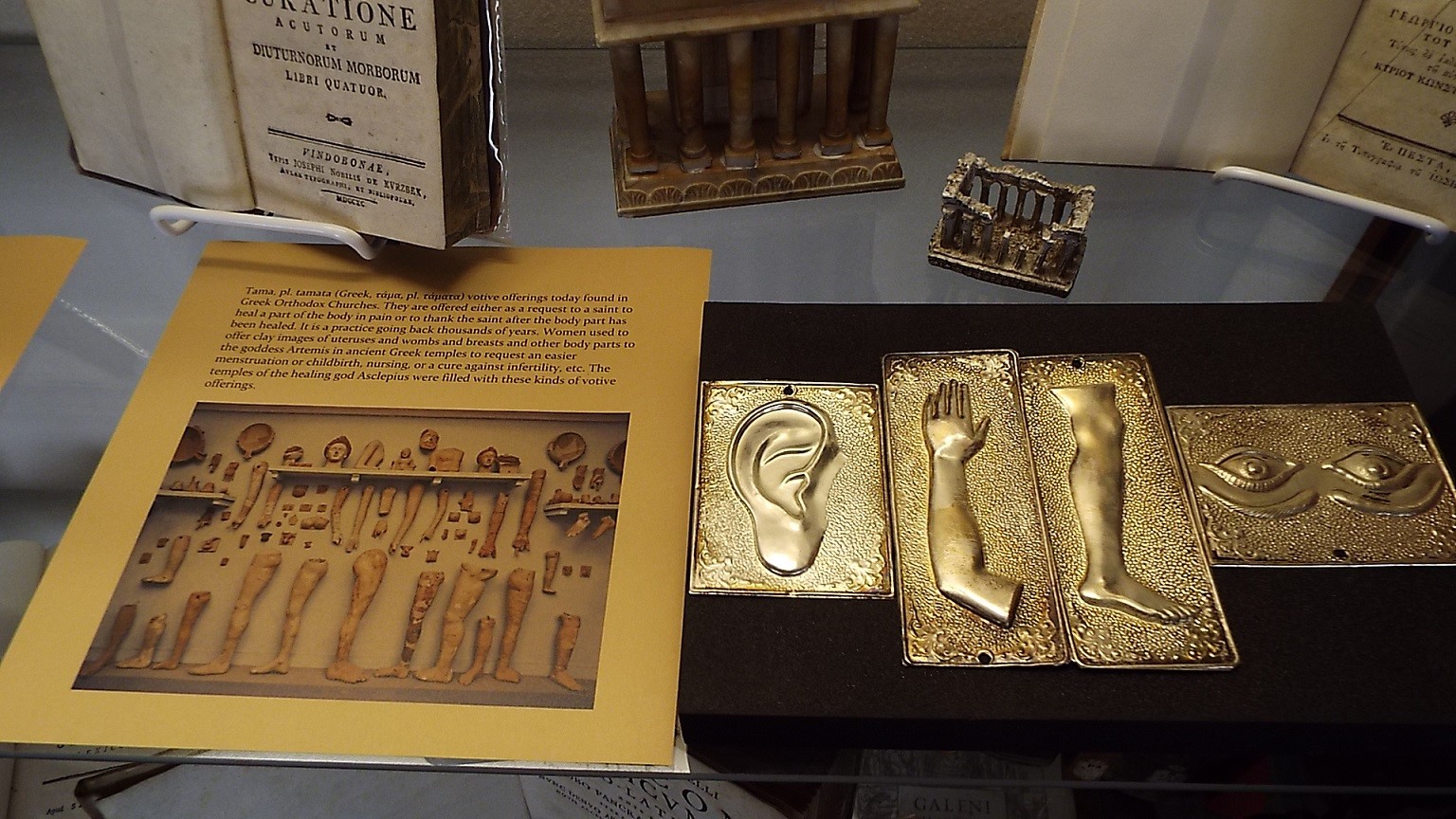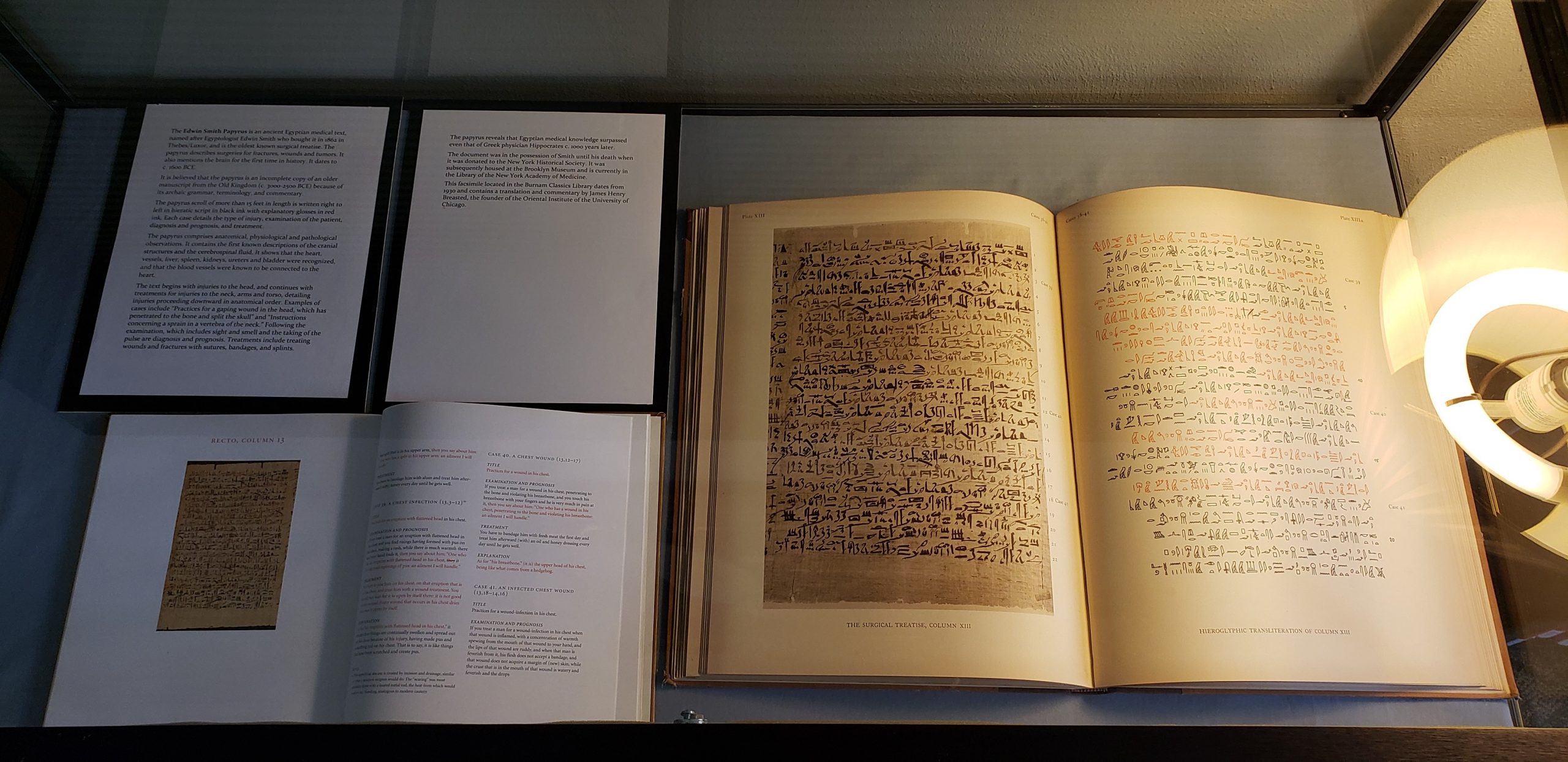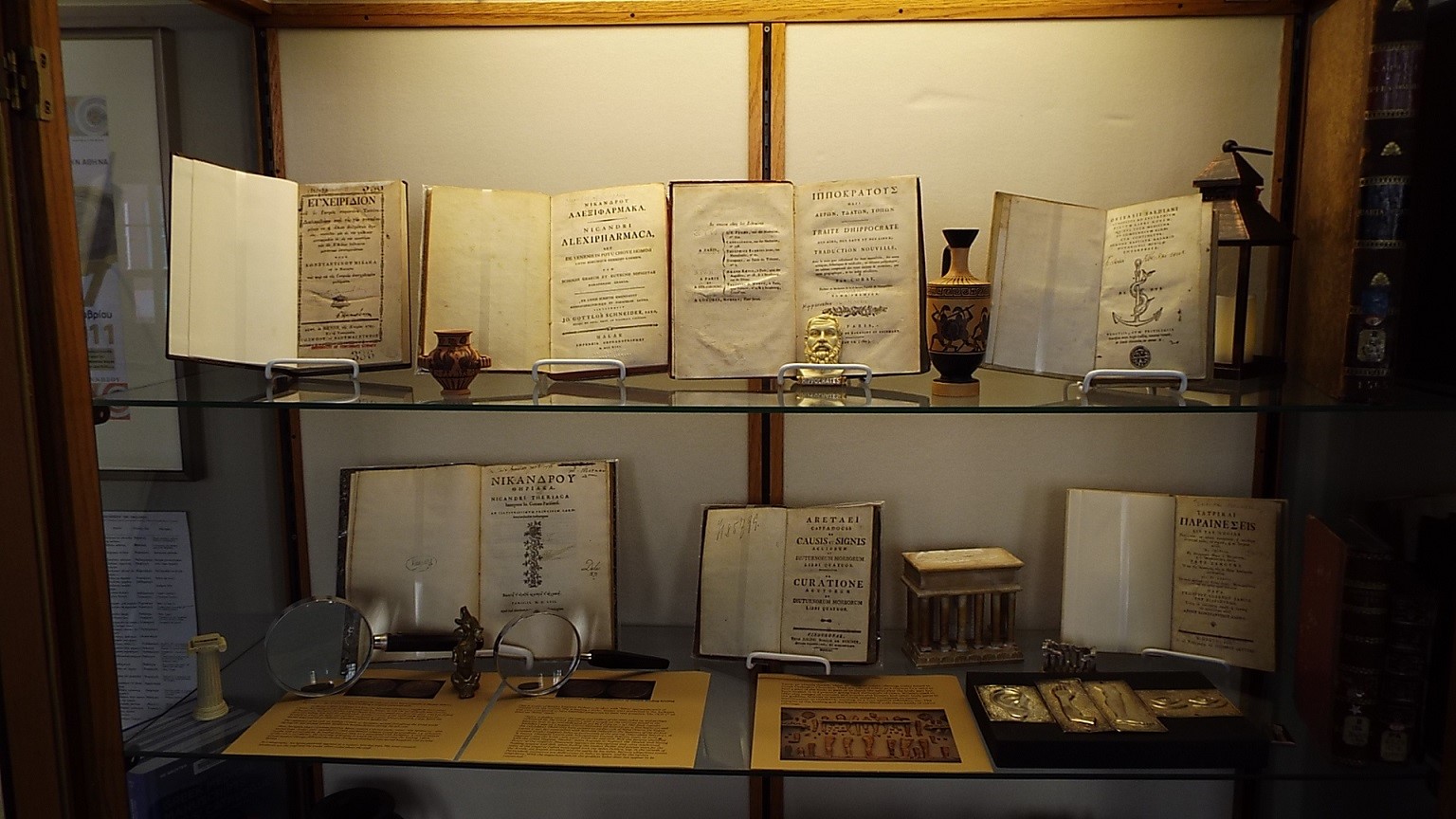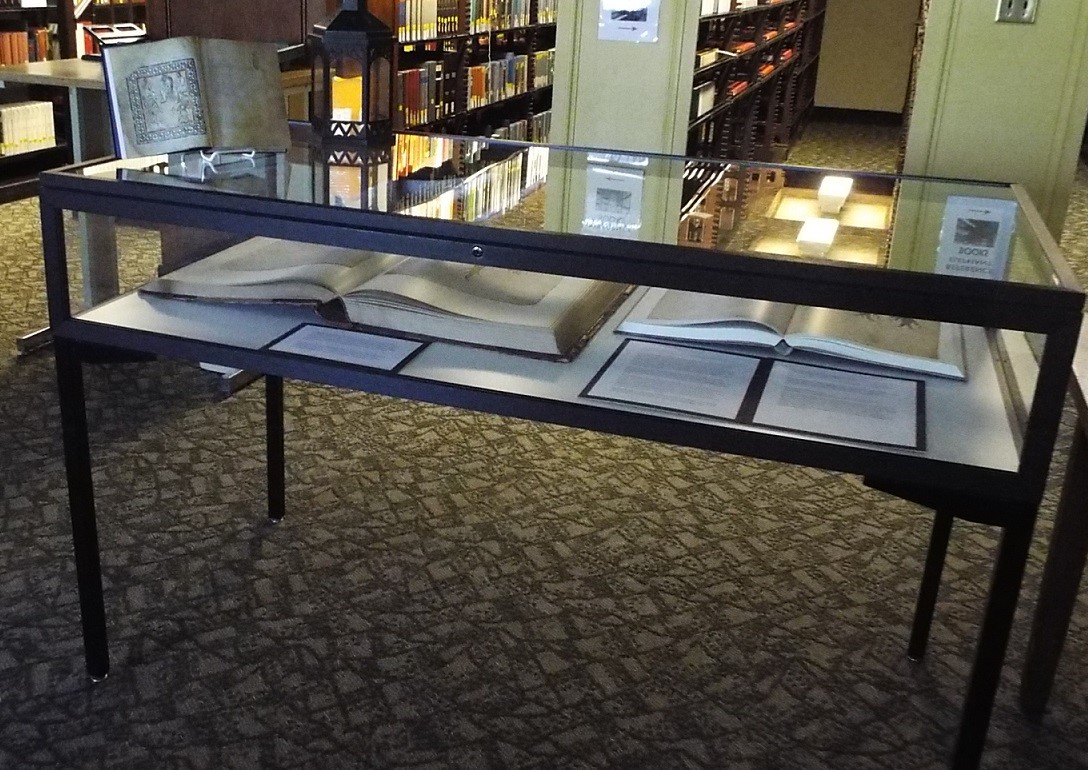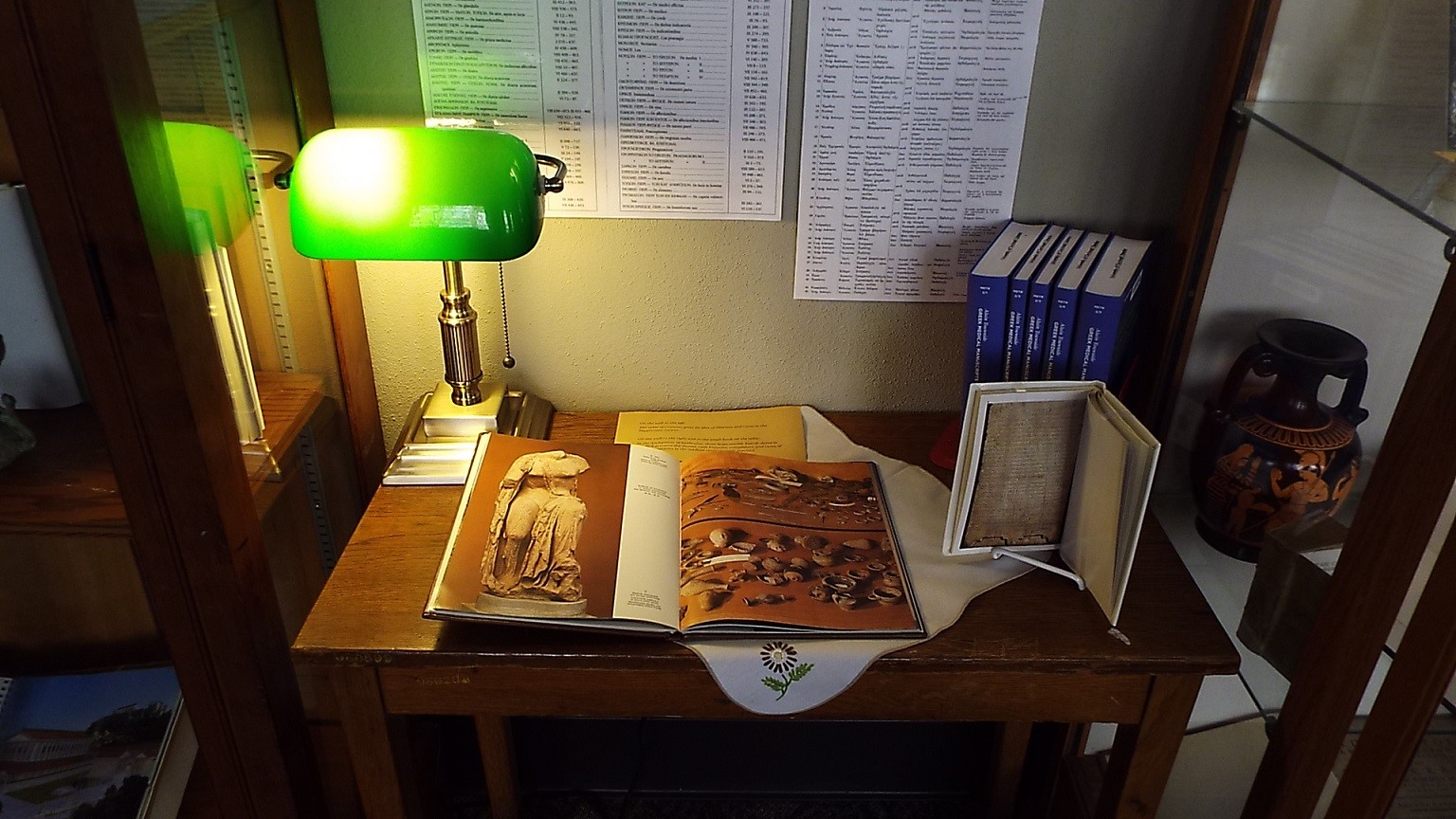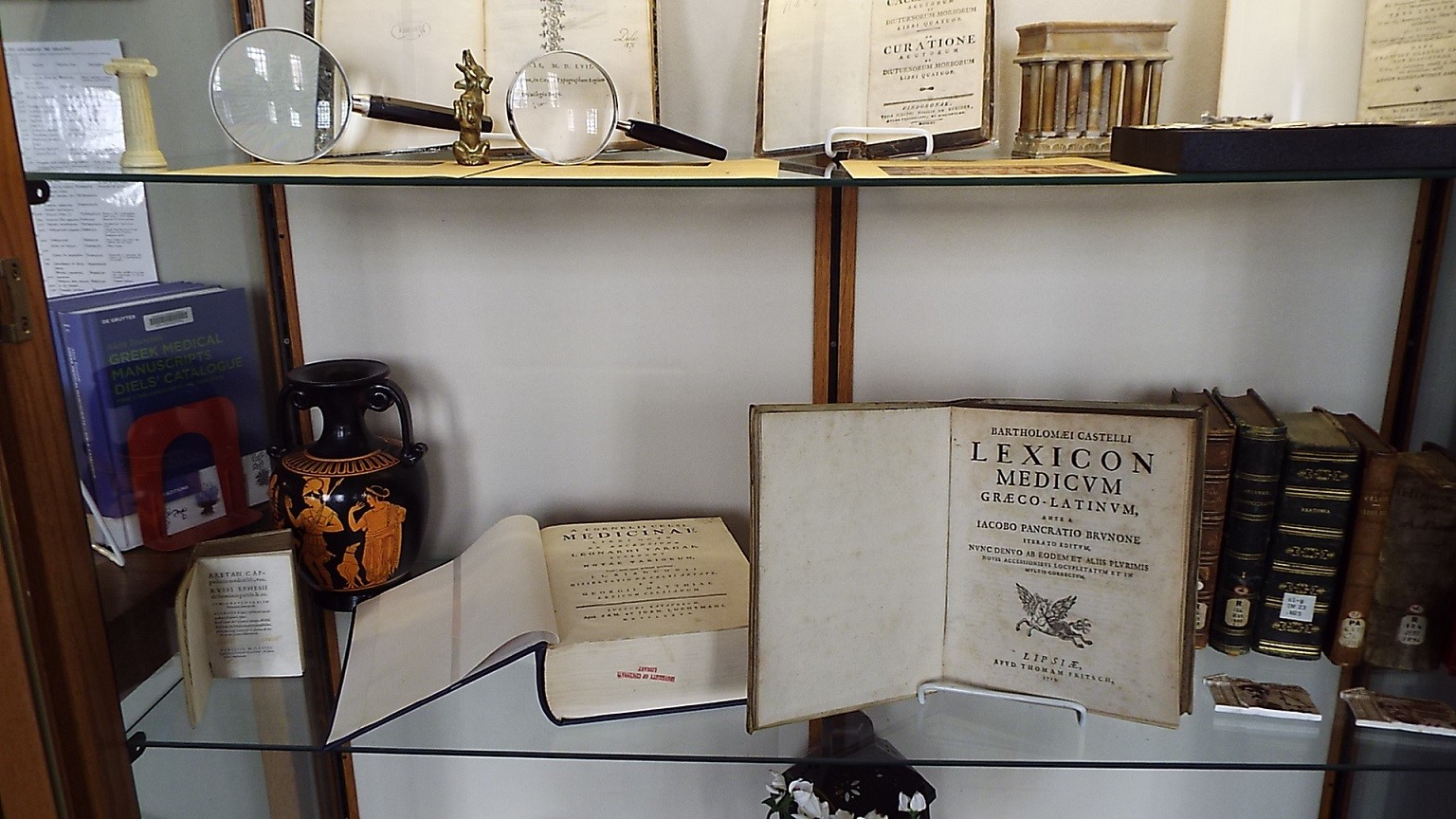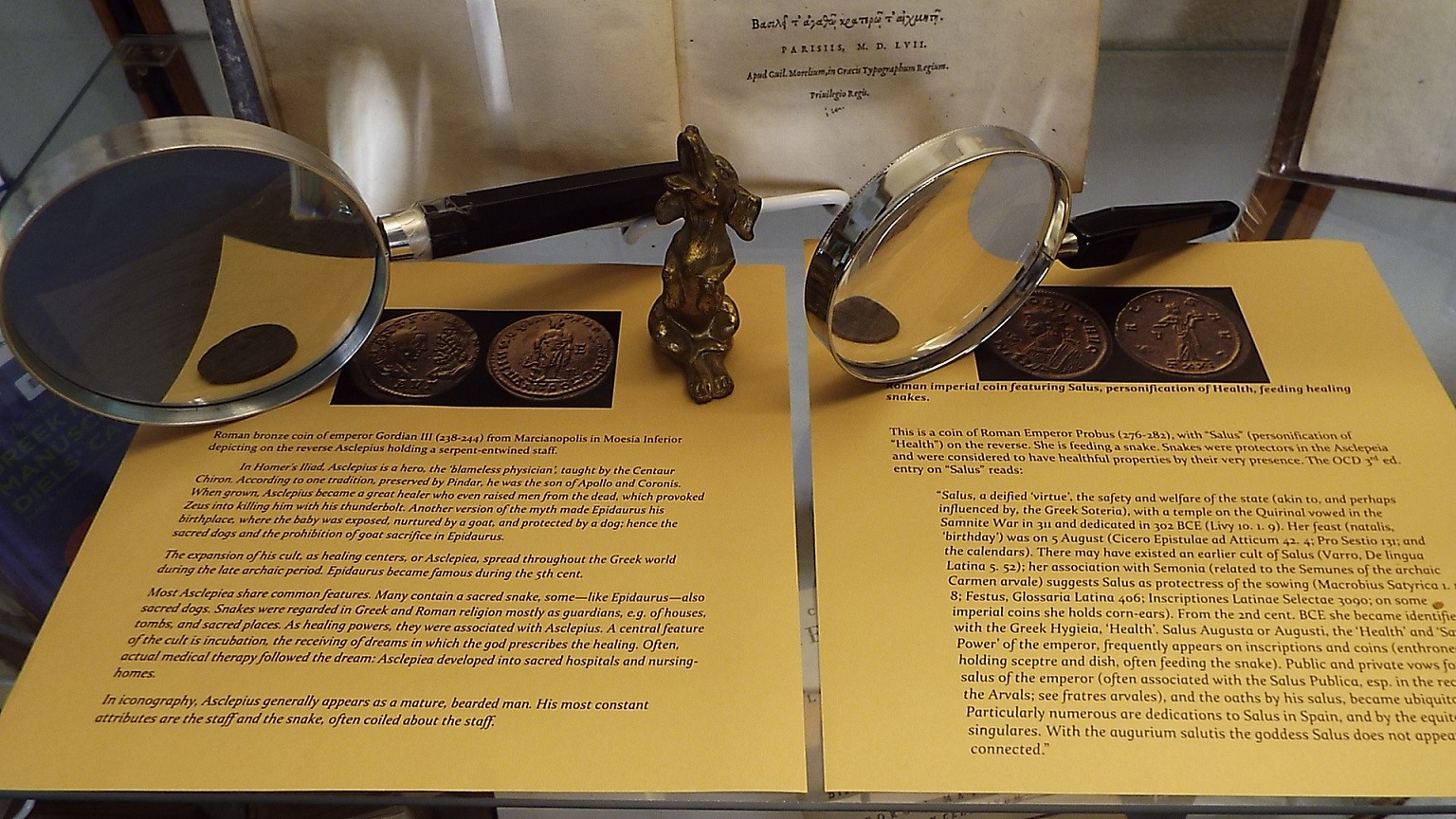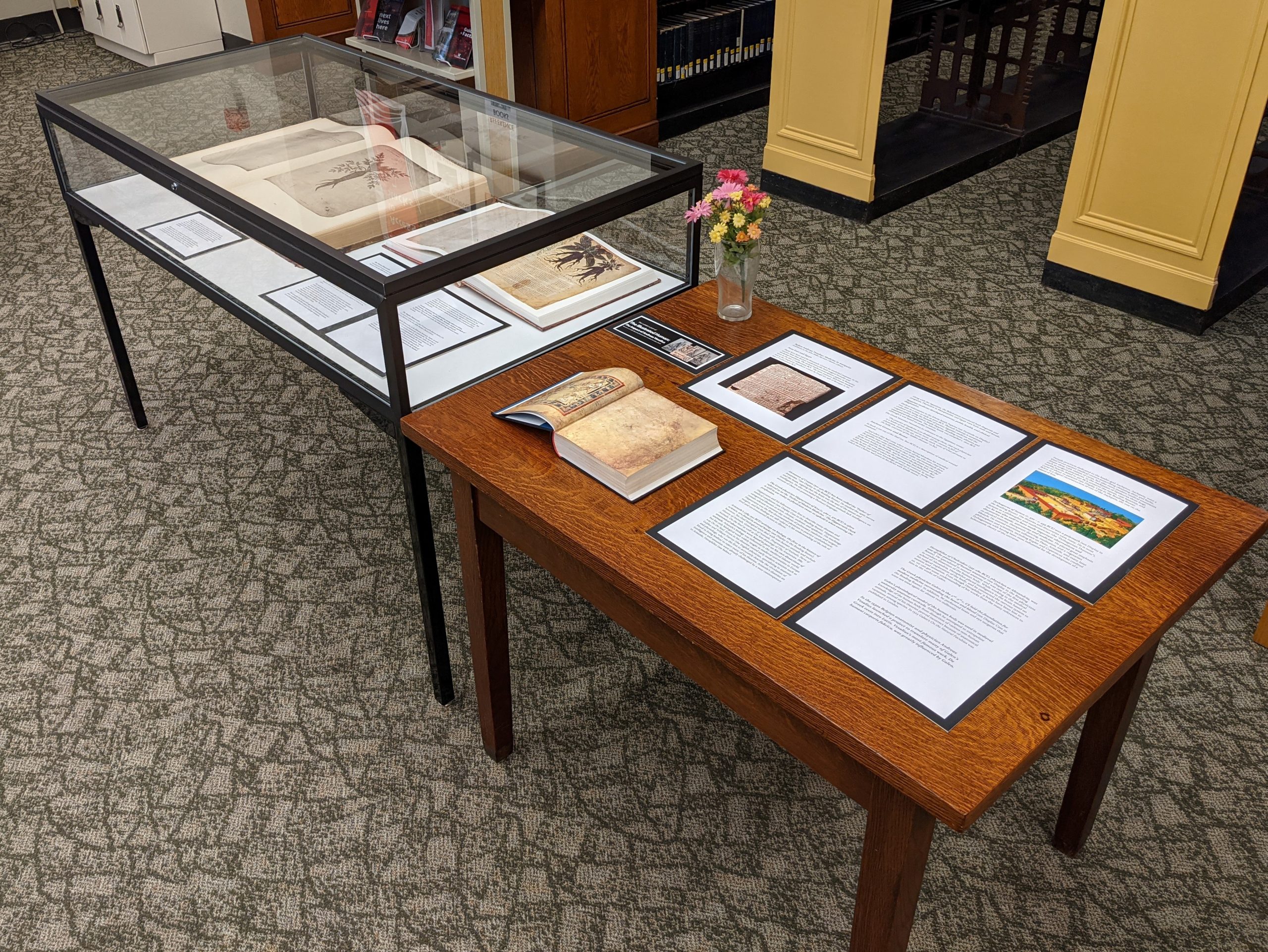Before Vesalius there were many ancient Greek physicians whose works influenced both those of Vesalius and other post-classical physicians; for example, Galen of Pergamum (129–c. 216 CE) whose works Vesalius translated and was greatly influenced by; Rufus of Ephesus (late 1st/early 2nd centuries CE) who wrote treatises on dietetics, pathology, anatomy, and gynaecology; Soranus of Ephesus (1st/2nd c. CE) author of a four-volume treatise on gynaecology; Pedanius Dioscurides (c. 40–90 CE), physician, pharmacologist, and botanist born in Cilicia, Asia Minor, and author of De Materia Medica, a 5-volume encyclopedia on herbal medicine which was widely read and used in medical schools and hospitals for more than 1,500 years. His work is included in the exhibition in the form of a rare and extraordinary facsimile of the original Byzantine manuscript referred to as the “Vienna Dioscurides” and another facsimile of a medieval manuscript referred to as the “Naples Dioscurides,” also featured in the exhibition; Asclepiades of Bithynia or of Prusa (c. 129/124–40 BCE) whose treatments included diet, exercise, and bathing; Herophilus of Alexandria (325-255 BCE), often called the “Father of Anatomy” who influenced Galen and was much quoted by him; Hippocrates of Kos (c. 460–c. 370 BCE), the “Father of (Modern) Medicine” and the author of the Hippocratic Oath, still in use today; Alcmaeon of Croton (510–430 BCE) who has also been called the “Father of Anatomy” although he, unlike Herophilus, did not dissect humans to examine human anatomy; Pythagoras of Samos (c. 570–c. 495 BCE) was a polymath, philosopher, mathematician, astronomer, physicist, music theorist and is said to have made important contributions to medicine as well, especially to what we today would call holistic medicine. Before the Greek medical texts there were The Edwin Smith Papyrus, an ancient Egyptian medical text and the oldest known surgical treatise on trauma from c. 1600 BCE, also featured in the exhibition, and the Babylonian medical text referred to as the Diagnostic Handbook, written by Esagil-kin-apli of Borsippa in the late 2nd millennium BCE.
Besides rare books and manuscript facsimiles of works by and about the above mentioned medical texts, the exhibition in the Classics Library features an original Greek coin (Roman provincial) depicting the Greek “God of Medicine,” Asclepius, and a Roman coin depicting Salus, personification of “Health.” Also featured are so called tamata, silver plaques depicting various ailing body parts common in Greek-Orthodox and some Roman-Catholic churches in contemporary Greece and Italy (on loan from Prof. Van Minnen), but they have a long tradition going back to antiquity where they were also offered, but made of clay, in the temples of Asclepius, the precincts of which functioned as health centers and spas with the healing presence of dogs and snakes, and in the temples of other gods and goddesses with healing abilities, for example, those of the goddess Artemis.
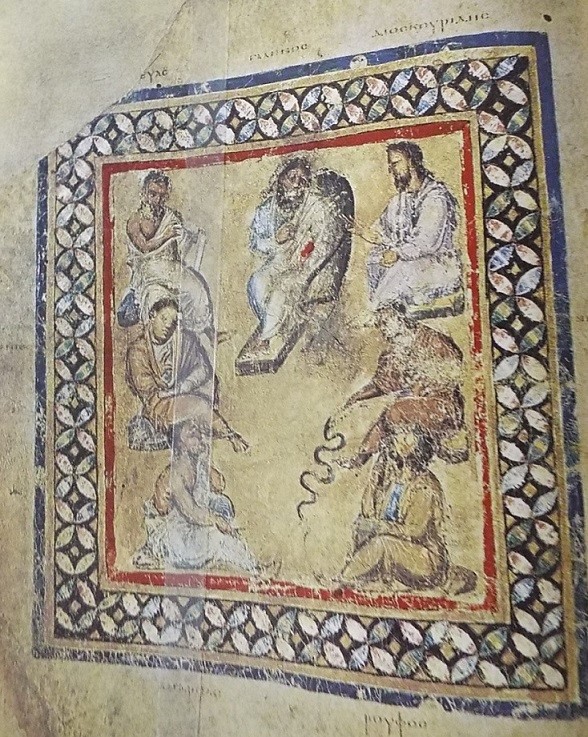
Miniature illustration from the “Vienna Dioscurides” (see above) featuring seven ancient Greek physicians: Galen, Crateuas (c. 100 BCE), Dioscurides, Apollonius Mys (1st c. BCE), Nicander of Colophon (c. 130 BCE), Andreas (c. 200 BCE), and Rufus of Ephesus. It is the earliest known manuscript to use a solid gold background.
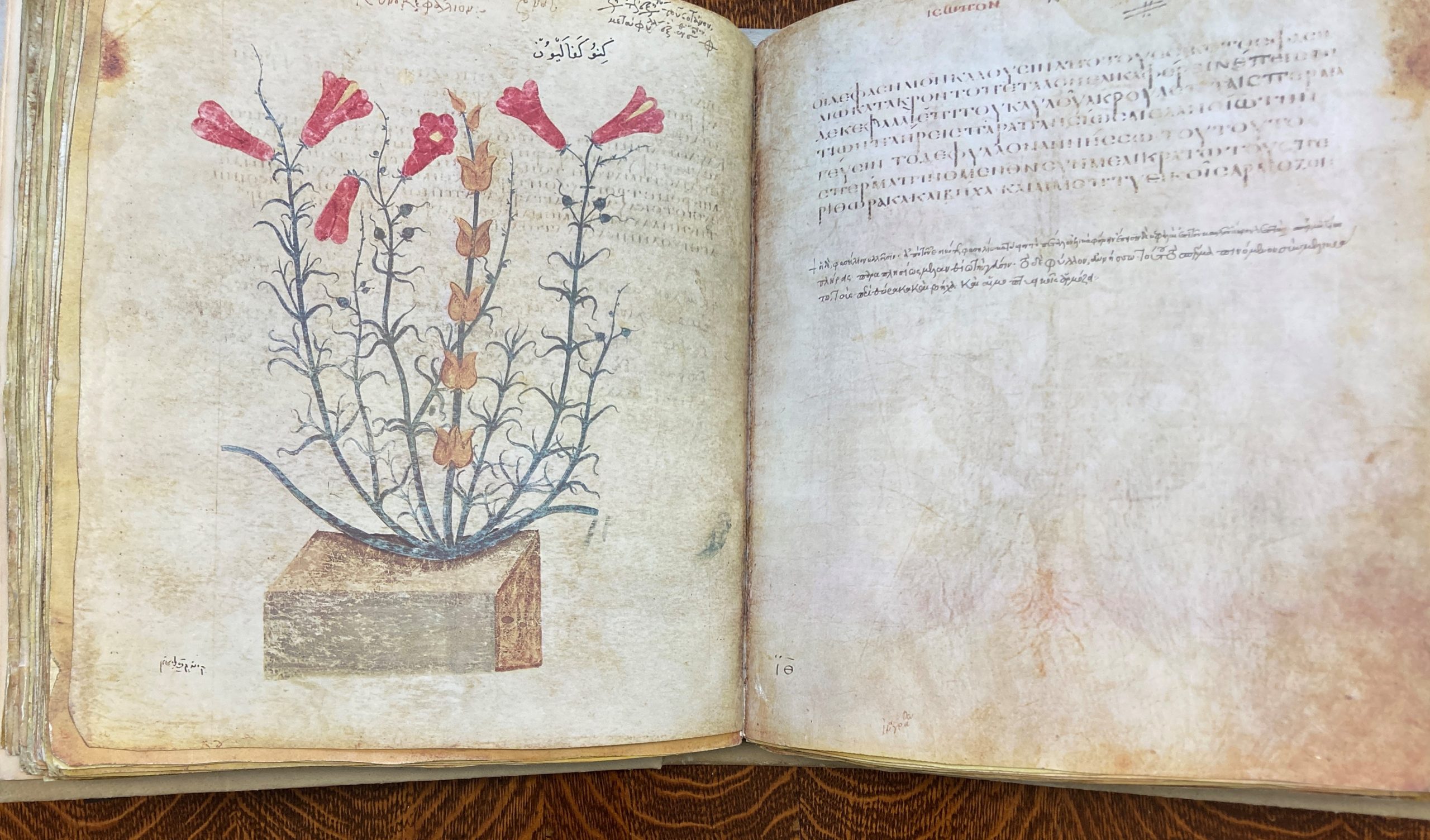
Herb from the superb facsimile of the “Vienna Dioscurides,” an early 6th-century Byzantine Greek illuminated codex of De materia medica (Περὶ ὕλης ἰατρικῆς).
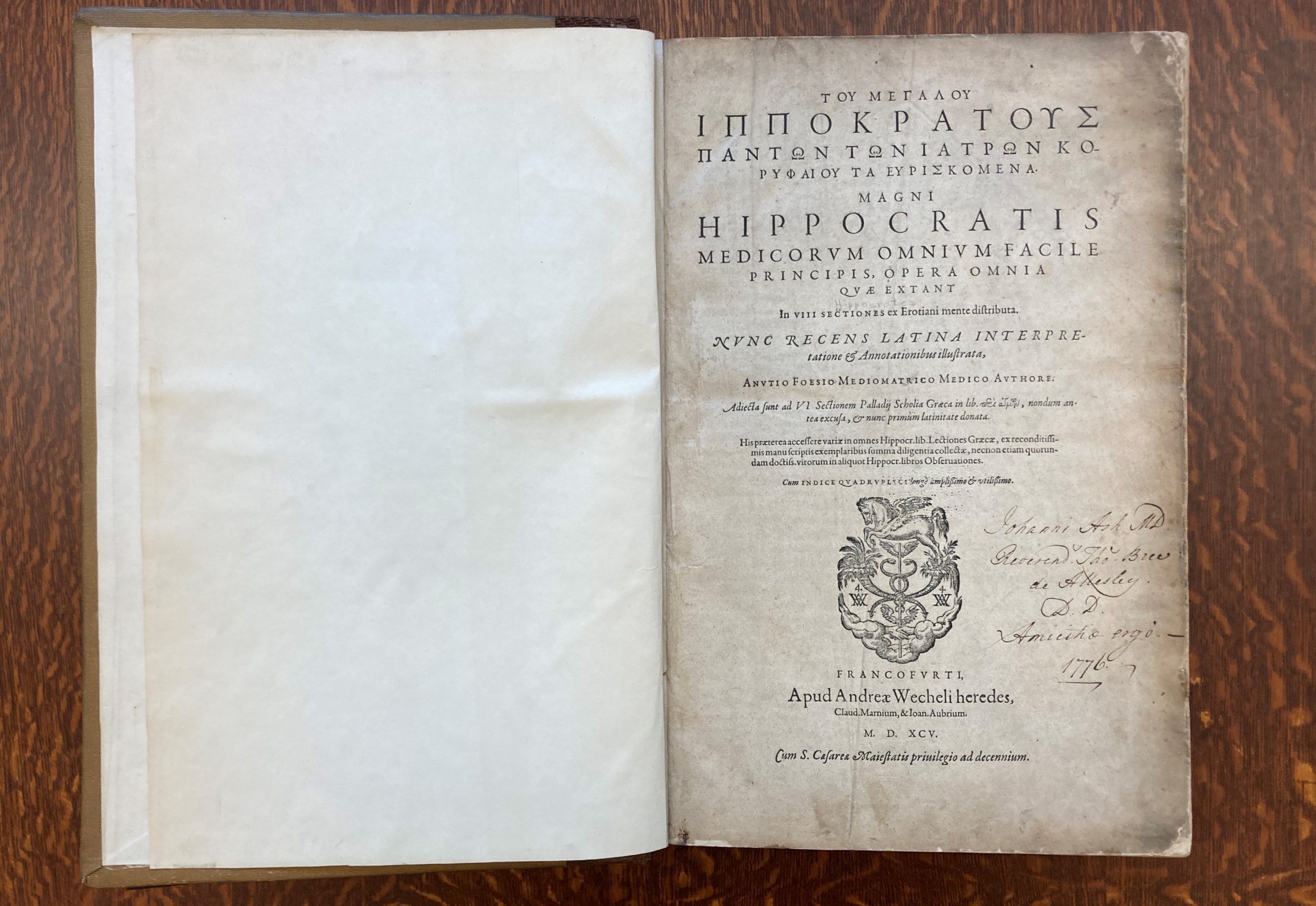
The Hippocratic corpus (opera omnia), bilingual (Greek and Latin) edition from 1595 with extensive scholia by a doctor from Metz, Anutius Foesius (1528-1595). It was the reference work on Hippocrates until Littré 250 years later. The printers were the heirs of Andreas Wechelus (d. 1581), who worked in Frankfurt and whose characteristic mark can be seen in the picture depicting Pegasus, Mercury’s caduceus (and a symbol of medicine, confused with Asclepius’ staff with one coiling snake), cornucopia, and clasped hands emerging from inside clouds. The book is divided into eight sections: The Hippocratic oath (Ius iurandum), Hippocratic law, a section dedicated to physicians, the nature of man, aphorisms (most famously, Gr. “Ὁ βίος βραχύς, δὲ τέχνη μακρή,” Lat. “Ars longa, vita brevis” (“Life is short, art is long”). Note that the Greek word “τέχνη” means skill, craft, practical knowledge and can refer to medicine as well as other practical disciplines, and not just to art. It’s the Greek word from which English ultimately acquired the word “techn-o (logy).” The Latin word “ars” also means skill, craft, practical knowledge. The English word “artisan” ultimately derives from this Latin word. The last section in the Hippocratic corpus deals with teeth.

Detail from the frontispiece of a Latin edition of the Galen corpus (opera omnia). Annotations and a vita by Conrad Gessner (1516-1565), a physician from Zürich. Printed in Venice by Tommaso Giunta (1494-1566) in 1565. It depicts Galen dissecting a pig with a number of prominent physicians in attendance. Andreas Vesalius was initially a student of Galen’s anatomy, but eventually distanced himself as he did not think that human anatomy could be understood through the dissection of animals. Instead, Vesalius turned to human cadavers.
To learn about the Vesalius exhibitions and lectures in Winkler, see The Illustrated Human: The Impact of Andreas Vesalius and This Page. 
Miniature painting from an illuminated “Book of Hours,” Très Riches Heures du Duc de Berry, from the early 15th century, now in Musée Condé, Chantilly (Ms. 65). This miniature of “Anatomical Zodiac Man,” which concludes the calendar on Folio 14, shows a nude hermaphrodite(?) or one male and one female in the mirror(?) with the twelve signs of the zodiac appearing over the corresponding anatomical regions. The celestial bodies contrasted with the human body. The then known seven planets are represented in a mandorla which is framed by another almond-shaped border with the signs of the zodiac. They are separated by plant decorations and scrolls with the Latin names of Aries, Taurus, etc., and should be read counter clock-wise, so first Virgo, then Libra, etc. The signs reoccur above the frontal anatomical areas of the youth, Aries stands on his/her head, Taurus rests on his/her shoulders, Gemini, representing the male and female principle, appear behind his/her upper arms, the fish of Pisces lies beneath his/her feet. The manuscript’s miniatures (66 large and 65 small on 206 parchment leaves) were painted by brothers Jean, Herman and Pol de Limbourg and completed by Jean Colombe. The Library’s facsimile of the illuminated manuscript does not contain “Anatomical Zodiac Man,” but it is featured in Codices illustres, published in Cologne and printed in Italy, a beautifully illustrated book on some of the world’s most famous illuminated manuscripts from 400 to 1600.
Above and below are some photos of the exhibition in the UC Classics Library.
